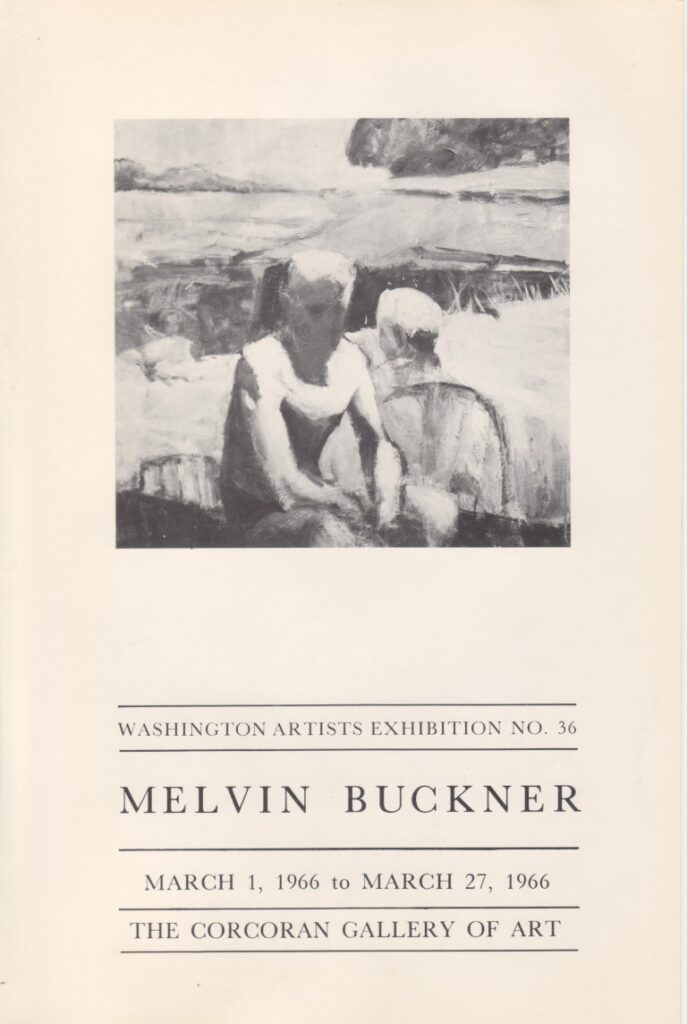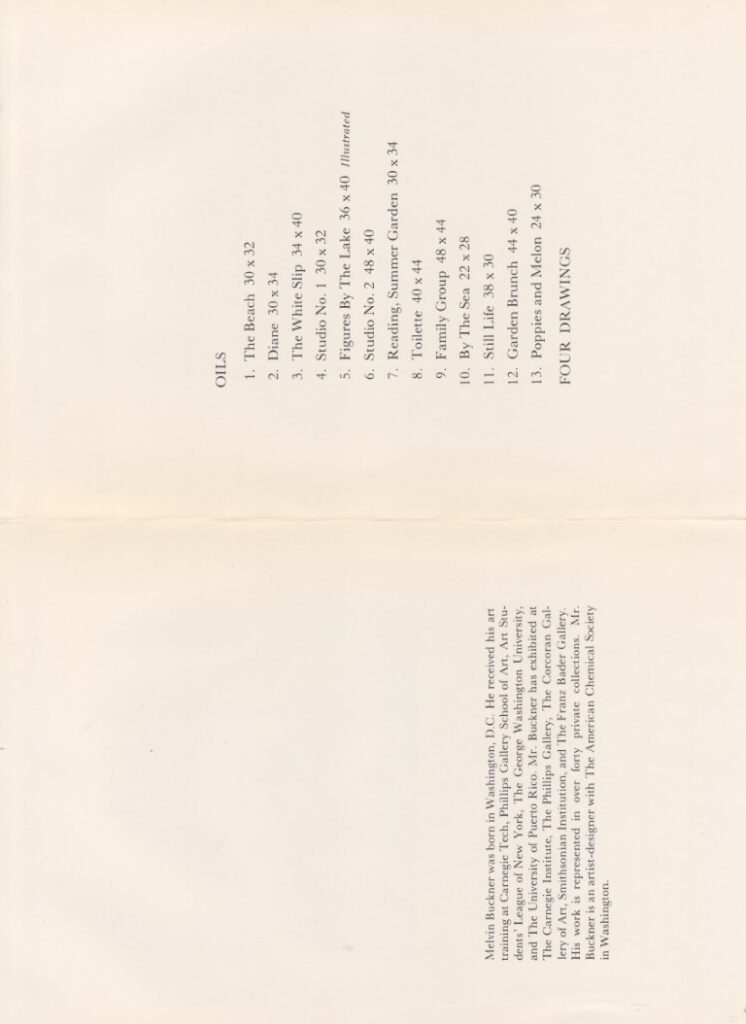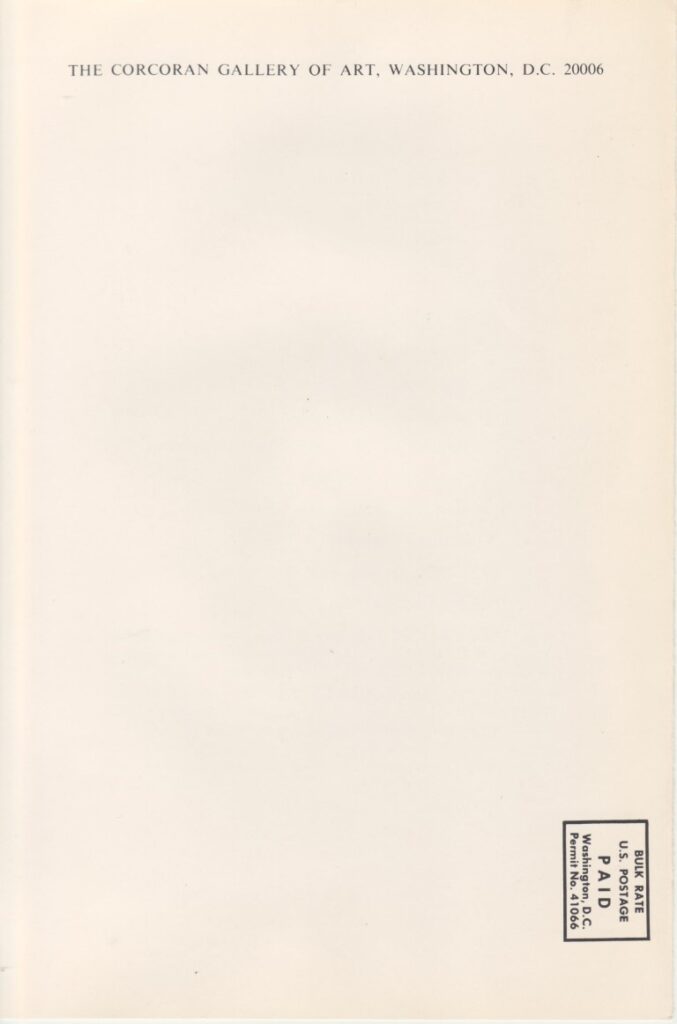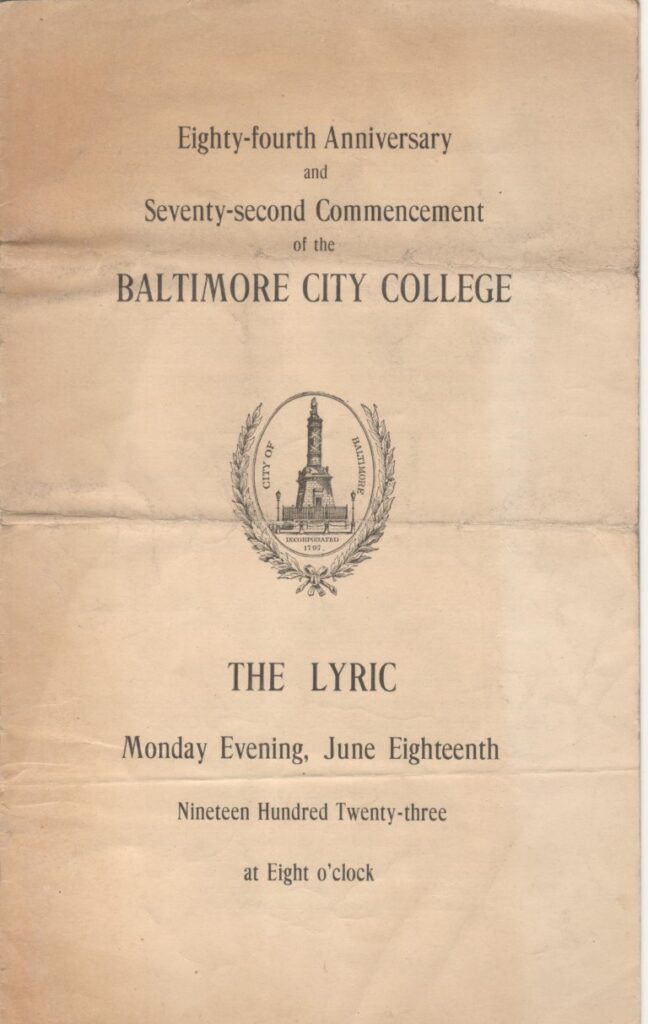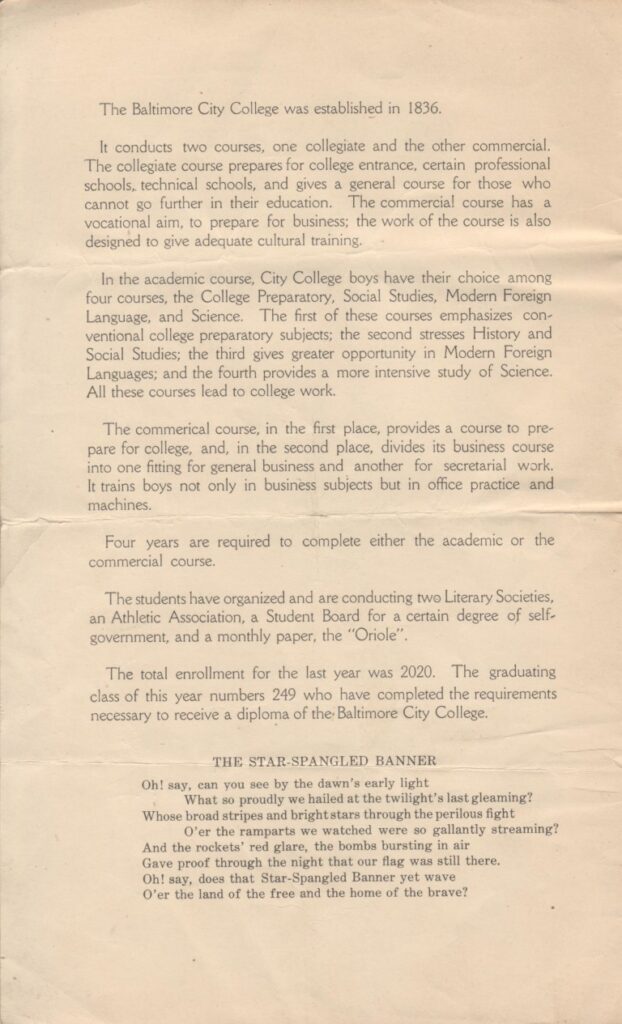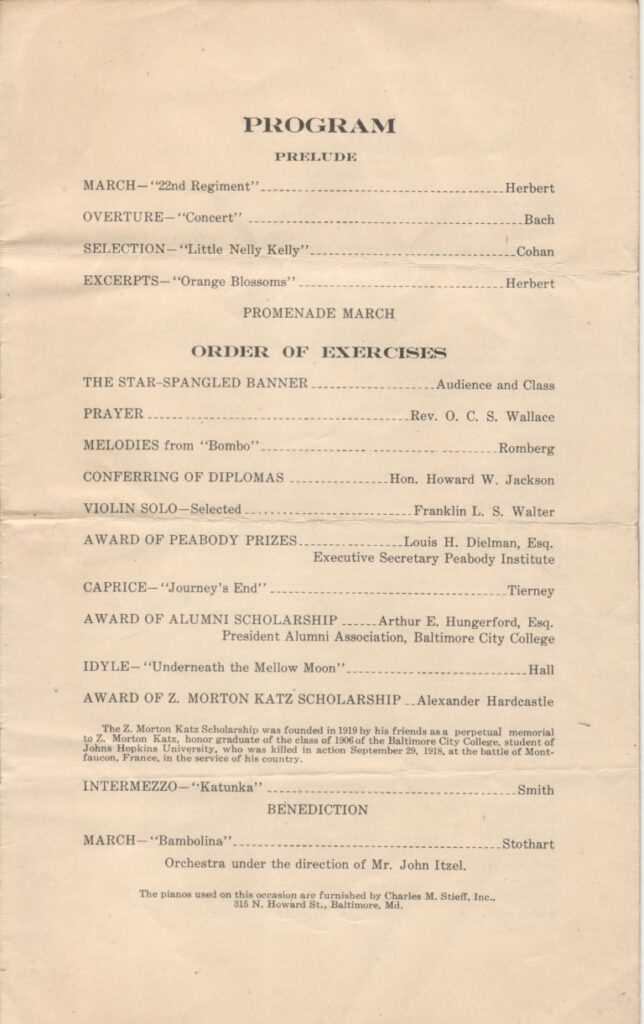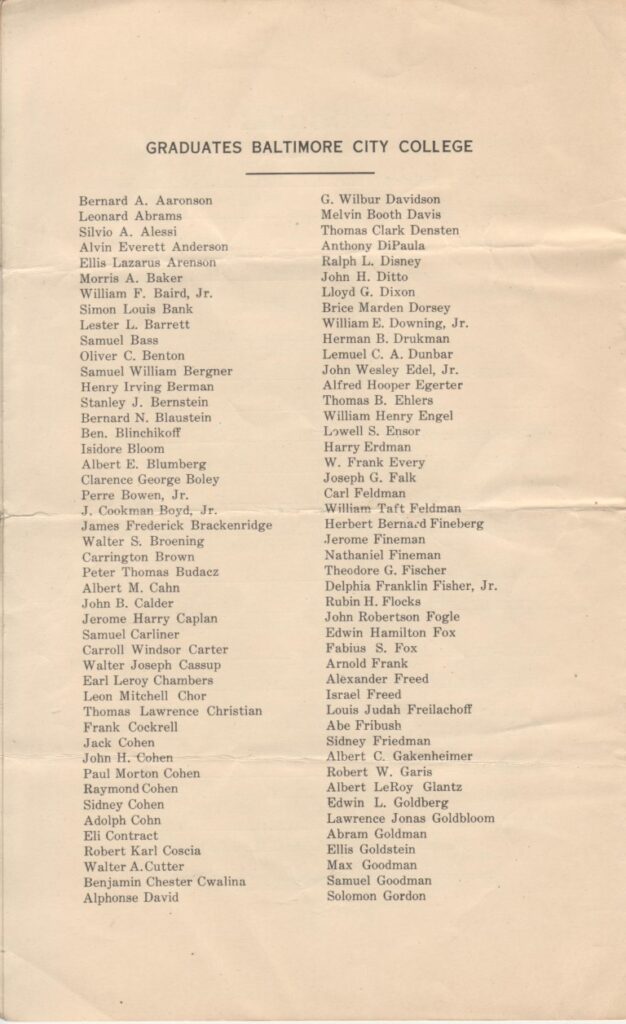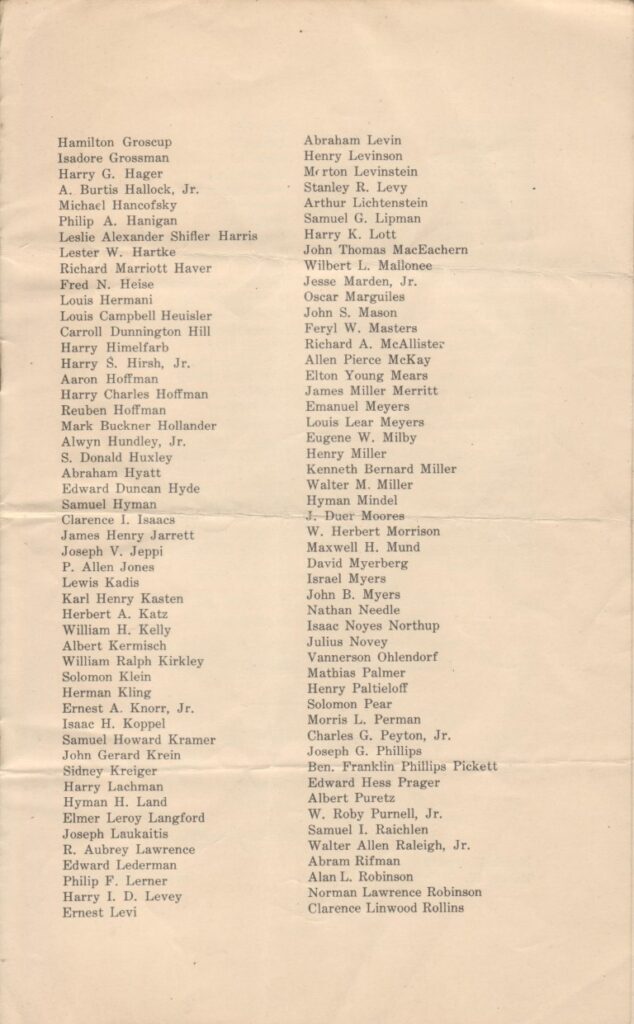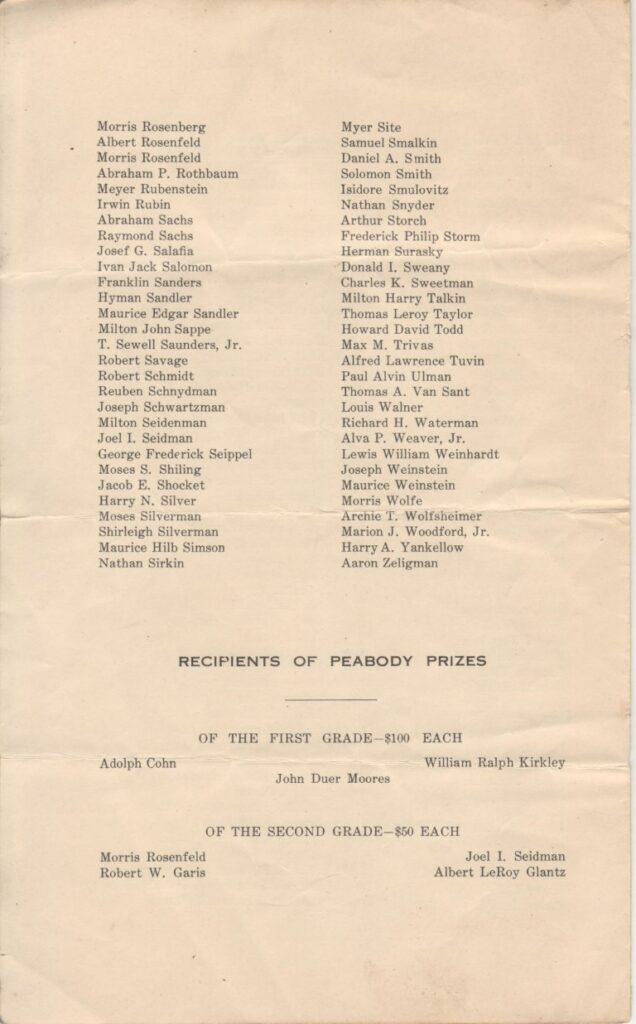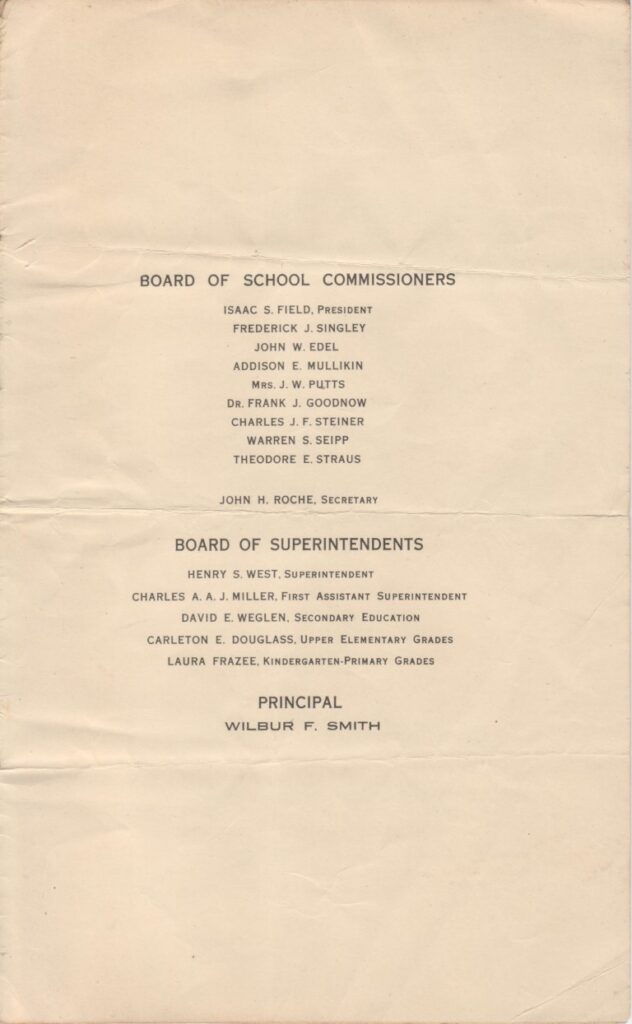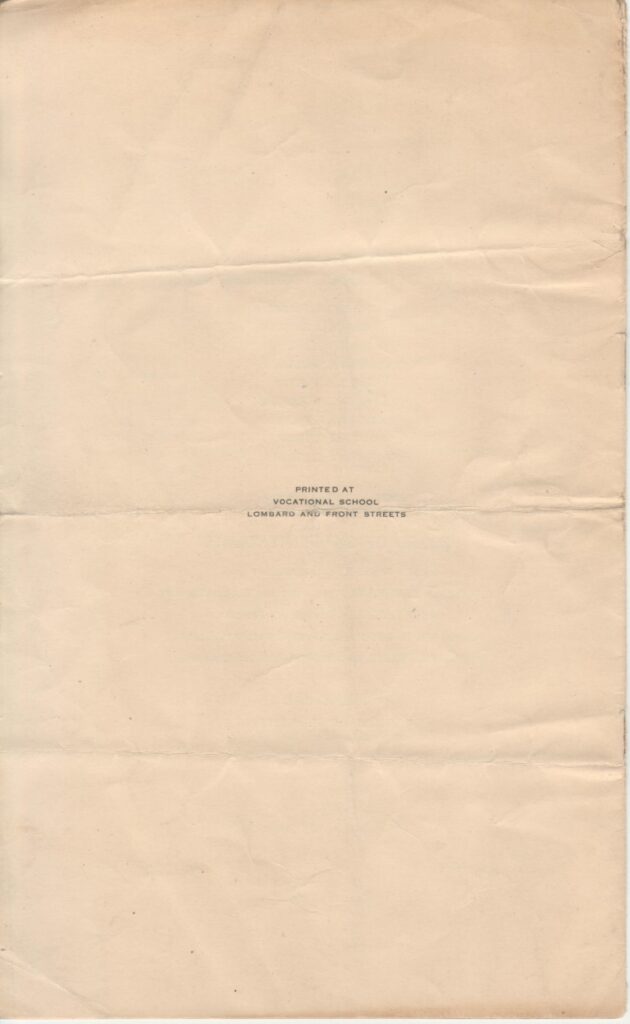SOUTHWEST JUNK SHOP STATEMENT (LEVY & BUCKNER, WASHINGTON D.C.)
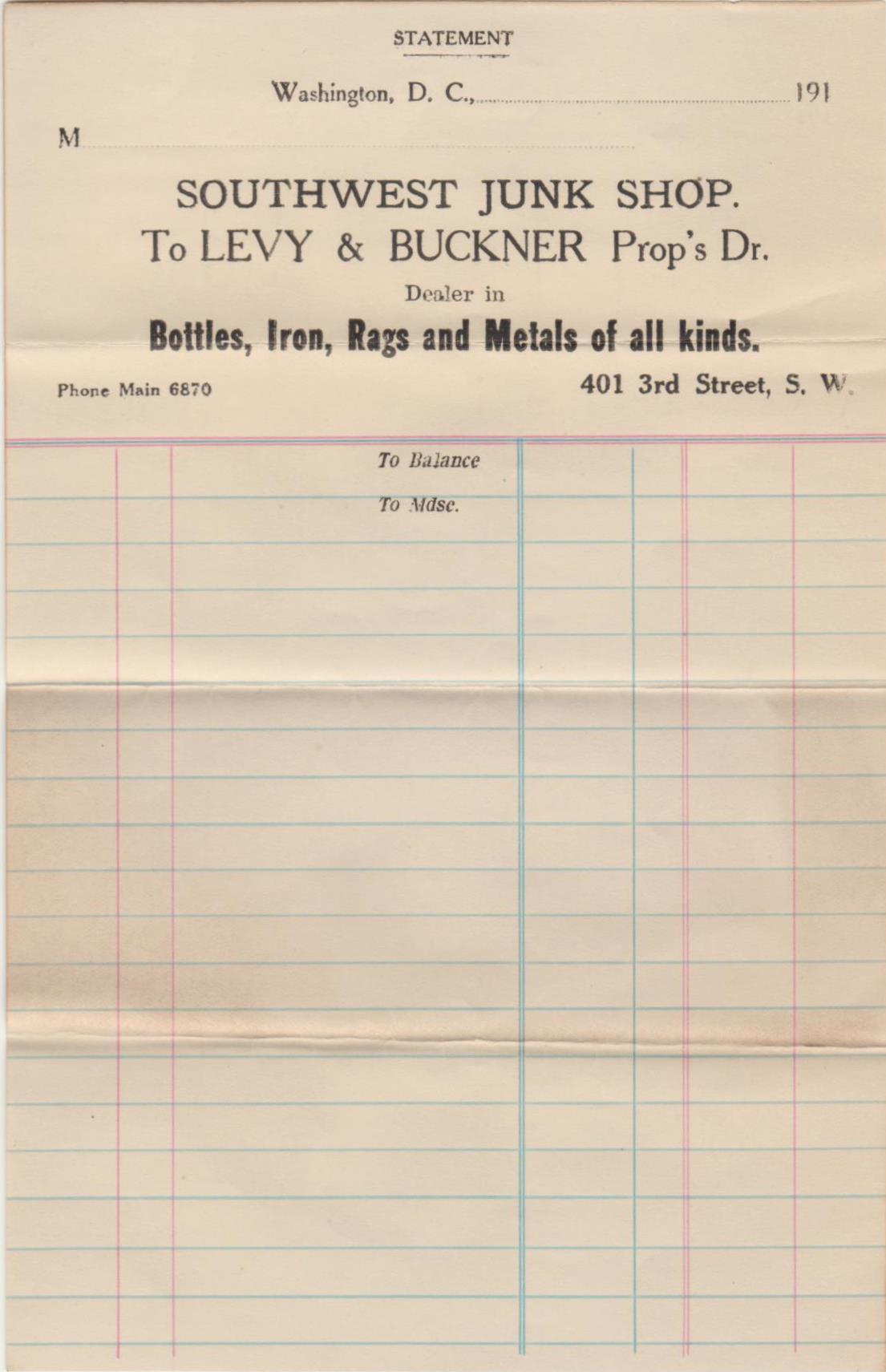 This image shows an unused or blank financial statement sheet from the Southwest Junk Shop, jointly operated by Levy & Buckner. Though undated, its typography, business model, and design suggest it originates from the early 20th century, likely between 1900 and 1930. It serves as a tangible relic of African-American and immigrant entrepreneurship in Washington, D.C.
This image shows an unused or blank financial statement sheet from the Southwest Junk Shop, jointly operated by Levy & Buckner. Though undated, its typography, business model, and design suggest it originates from the early 20th century, likely between 1900 and 1930. It serves as a tangible relic of African-American and immigrant entrepreneurship in Washington, D.C.
REASONING AND HISTORICAL CONTEXT
- Location:
The address listed—401 3rd Street, S.W., Washington, D.C.—places this shop in a historic working-class neighbourhood known for industrial and warehousing activities, particularly in the early 20th century. It was near the waterfront and rail lines, ideal for junk and scrap businesses. - Business Type:
The phrase “Dealer in Bottles, Iron, Rags and Metals of all kinds” reflects a classic “junk dealer” model, common in cities at the time. These businesses were essential to early urban recycling and provided accessible entrepreneurial opportunities for minorities and immigrants. - Ownership – LEVY & BUCKNER:
The name Buckner aligns with Melvin Daniel Buckner (1915–2010), whose long-term partner was Edwin Reid Morrison (1916–2000). While we cannot definitively confirm that Melvin Buckner was involved with this shop, the coincidence of name and Washington D.C. location is compelling—especially since Melvin lived in D.C. in his youth and early adulthood. If this document is indeed tied to him or his family, it gives rare insight into working-class Black entrepreneurship during a period when such records are often lost or undocumented. - Phone Number – “Main 6870”:
The use of a four-digit number with a named exchange (“Main”) was standard before the 1940s. This supports the idea that the document is pre-WWII, further narrowing its date to likely between 1910 and 1935. - Form Purpose:
This was a blank statement ledger, used for recording transactions with customers—credits, balances, and payments. “To Balance” and “To Mdse.” (merchandise) were standard columns. It would have been folded and handed or mailed as part of regular bookkeeping.
These images document the 1966 solo exhibition of artist Melvin Buckner at the Corcoran Gallery of Art, one of Washington D.C.’s most prestigious art institutions. The exhibition ran from March 1 to March 27, 1966, as part of the Washington Artists Exhibition series (No. 36).
This is a significant milestone in Melvin Buckner’s career, offering concrete recognition from a major cultural institution. It affirms that by the mid-1960s, Buckner was an established name in the Washington art scene, respected enough to be granted a solo show featuring both oils and drawings.
The works listed reveal a focus on figurative and domestic themes, with titles such as The Beach, Figures by the Lake, Family Group, and Toilette. There is a gentle intimacy to his subject matter, suggesting a personal and observational artistic approach—consistent with what we know of Melvin’s quietly powerful body of work.
The final biographical note confirms that Buckner was born in Washington, D.C., trained at Howard University and The Corcoran School of Art, and exhibited at other major galleries like The Phillips Collection and Gallery 10. His professional status at the time is listed as “artist-designer with The American Chemical Society,” indicating a dual career in art and applied design.
Full Transcription
Cover Page:
THE CORCORAN GALLERY OF ART, WASHINGTON, D.C. 20006
[Image: Painting of two abstracted figures sitting on beach chairs]
WASHINGTON ARTISTS EXHIBITION NO. 36
MELVIN BUCKNER
MARCH 1, 1966 to MARCH 27, 1966
THE CORCORAN GALLERY OF ART
Page 2–3 (Exhibition Checklist and Biography):
OILS
- The Beach 30 x 32
- Diane 30 x 34
- The White Slip 34 x 40
- Studio No. 1 30 x 32
- Figures By The Lake 36 x 40 *illustrated*
- Studio No. 2 48 x 46
- Reading – Summer Garden 30 x 34
- Toilette 40 x 44
- Family Group 48 x 44
- By The Sea 32 x 22
- Still Life 38 x 30
- Garden Brunch 44 x 40
- Poppies and Melon 24 x 30
FOUR DRAWINGS
Melvin Buckner was born in Washington, D.C. He received his art
training at Howard University, the Corcoran School of Art,
George Washington University, and the City College of New York.
His work has been exhibited at the Phillips Gallery, the
Carnegie Institute, the Corcoran Gallery, and Gallery 10.
The Corcoran Gallery, The Phillips Collection, Mr. J. Heywood Alexander, Jr., and a number of private collectors own Buckner’s work.
He is represented in Who’s Who in American Art. Mr.
Buckner is an artist-designer with The American Chemical Society in Washington.
Baltimore City College Commencement Exercises — Lyric Theatre, Monday Evening, June the Eighteenth, Nineteen Hundred Twenty-three, at Eight-Fifteen O’Clock.”
“THE LYRIC
Monday Evening, June Eighteenth
Nineteen Hundred Twenty-three
at Eight o’clock”
First up: Pages 1 and 2. Let me proceed.
📜 Transcription: Baltimore City College Commencement Program
Date: Monday Evening, June 18, 1923
Location: Baltimore, Maryland
Time: 8 o’clock
🟫 Page 1 (Title Page)
– THE – LYRIC
Monday Evening, June Eighteenth
Nineteen Hundred Twenty-three
at Eight o’clock
Page 2 (Introduction and Anthem)
The Baltimore City College was established in 1836.
It conducts two courses, one collegiate and the other commercial. The collegiate course prepares for college entrance, certain professional schools, technical schools, and gives a general course for those who cannot go further in their education. The commercial course has a vocational aim, to prepare for business; the work of the course is also designed to give adequate cultural training.
In the academic course, City College boys have their choice among four courses:
- College Preparatory
- Social Studies
- Modern Foreign Language
- Science
The first of these courses emphasizes conventional college preparatory subjects; the second stresses history and social studies; the third gives greater opportunity in modern foreign languages; and the fourth provides a more intensive study of science. All these courses lead to college work.
The commercial course, in the first place, provides a course to prepare for college, and, in the second place, divides its business course into one fitting for general business and another for secretarial work. It trains boys not only in business subjects but in office practice and machines.
Four years are required to complete either the academic or the commercial course.
The students have organized and are conducting two Literary Societies, an Athletic Association, a Student Board for a certain degree of self-government, and a monthly paper, the Oriole.
The total enrollment for the last year was 2,020. The graduating class of this year numbers 249 who have completed the requirements necessary to receive a diploma of the Baltimore City College.
🎶The Star-Spangled Banner
Oh! say, can you see by the dawn’s early light
What so proudly we hailed at the twilight’s last gleaming?
Whose broad stripes and bright stars through the perilous fight
O’er the ramparts we watched were so gallantly streaming?
And the rockets’ red glare, the bombs bursting in air
Gave proof through the night that our flag was still there.
Oh! say, does that Star-Spangled Banner yet wave
O’er the land of the free and the home of the brave?
Context & Reasoning:
The images you’ve provided come from a 1923 commencement booklet of Baltimore City College, a historic public high school in Baltimore, Maryland. The first image (Page 3) contains the program schedule and order of exercises, including musical interludes, award presentations, and official speeches. The second image (Page 4) is a list of graduates for that year, beginning with surnames starting from “Aaronson” through “Flocks.”
The presence of detailed musical numbers, diploma conferment, and scholarship awards—including a notable one in honour of Z. Morton Katz (a WWI casualty)—indicates a deeply ceremonial, community-minded event, blending patriotism, remembrance, and celebration.
Transcription (Pages 3 and 4):
Baltimore City College – Commencement Program (18th June 1923)
PROGRAM
PRELUDE
MARCH — “2nd Regiment” ………… Herbert
OVERTURE — “Comerís” …………… Bach
SELECTION — “Little Nelly Kelly”
EXCERPTS — “Orange Blossoms”
PROMENADE MARCH
ORDER OF EXERCISES
THE STAR-SPANGLED BANNER ………… Audience and Class
Invocation ……………. Rev. D. C. S. Wallace
Duet — “Song from Bombo” ………….. De Romberg
CONFERRING OF DIPLOMAS …………. Hon. Howard W. Jackson
VIOLIN SOLO — Selected ……………. Franklin L. Walter
Address ……………. Louis H. Dielman, Esq.
Executive Secretary, Peabody Institute
SOLO — “Journey’s End” …………….. Tierney
AWARD OF ALUMNI SCHOLARSHIP ……… Arthur E. Hungerford, Esq.
President, Alumni Association, Baltimore City College
IDYLE — “Underneath the Mellow Moon” ………. Hall AWARD OF Z. MORTON KATZ SCHOLARSHIP ………. Alexander Hardcastle
The Z. Morton Katz Scholarship was founded in 1919 by his friends as a perpetual memorial
to Z. Morton Katz, honor graduate of the class of 1906 of the Baltimore City College, student of
Johns Hopkins University, who was killed in action September 29, 1918, at the battle of Mont-
faucon, France, in the service of his country.
INTERMEZZO — “Katunka”
MARCH — “Bambolina” ……………… Stothart
Orchestra under the direction of Mr. John Itzel.
The pianos used on this occasion are furnished by Charles M. Stieff, Inc.,
15 N. Howard St., Baltimore, Md.
Graduates of Baltimore City College (1923)
GRADUATES BALTIMORE CITY COLLEGE
Bernard A. Aaronson
Leonard Abrams
Silvio A. Alessi
Alvin Everett Anderson
Ellis Lazarus Arenson
Morris A. Baker
William F. Baird, Jr.
Simon Louis Bank
Lester L. Barrett
Samuel Bass
Oliver C. Benton
Samuel William Bergner
Henry Irving Berman
Stanley J. Bernstein
Bernard N. Blaustein
Ben Blinchikoff
Isidore Bloom
Albert E. Blumberg
Clarence George Boley
Perre Bowen, Jr.
Cookman Boyd, Jr.
James Frederick Brackenridge
Walter S. Broening
Carrington Brown
Peter Thomas Budacz
Albert M. Cahn
John B. Calder
Jerome Harry Caplan
Samuel Carliner
Carroll Windsor Carter
Walter Joseph Cassup
Earl Leroy Chambers
Leon Mitchell Chor
Thomas Lawrence Christian
Frank Cockrell
Jack Cohen
John H. Cohen
Paul Morton Cohen
Raymond Cohen
Sidney Cohen
Adolph Cohn
Eli Contract
Robert Karl Coscia
Walter A. Cutter
Benjamin Chester Cwalina
Alphonse David
Wilbur Davidson
Melvin Booth Davis
Thomas Clark Densten
Anthony DiPaula
Ralph L. Disney
John H. Ditto
Lloyd G. Dixon
Brice Marden Dorsey
William E. Downing, Jr.
Herman B. Drukman
Lemuel C. A. Dunbar
John Wesley Edel, Jr.
Alfred Hooper Egerter
Thomas B. Ehlers
William Henry Engel
Lowell S. Ensor
Harry Erdman
Frank Every
Joseph G. Falk
Carl Feldman
William Taft Feldman
Herbert Bernard Fineberg
Jerome Fineman
Nathaniel Fineman
Theodore G. Fischer
Delphia Franklin Fisher, Jr.
Rubin H. Flocks
Morris Rosenberg
Albert Rosenfeld
Morris Rosenfeld
Abraham P. Rothbaum
Meyer Rubenstein
Irwin Rubin
Abraham Sachs
Raymond Sachs
Josef G. Salafia
Ivan Jack Salomon
Franklin Sanders
Hyman Sandler
Maurice Edgar Sandler
Milton John Sappe
Sewell Saunders, Jr.
Robert Savage
Robert Schmidt
Reuben Schnydman
Joseph Schwartzman
Milton Seidenman
Joel I. Seidman
George Frederick Seippel
Moses S. Shiling
Jacob E. Shocket
Harry N. Silver
Moses Silverman
Shirleigh Silverman
Maurice Hilb Simson
Nathan Sirkin
Myer Site
Samuel Smalkin
Daniel A. Smith
Solomon Smith
Isidore Smulovitz
Nathan Snyder
Arthur Storch
Frederick Philip Storm
Herman Surasky
Donald I. Sweany
Charles K. Sweetman
Milton Harry Talkin
Thomas Leroy Taylor
Howard David Todd
Max M. Trivas
Alfred Lawrence Tuvin
Paul Alvin Ulman
Thomas A. Van Sant
Louis Walner
Richard H. Waterman
Alva P. Weaver, Jr.
Lewis William Weinhardt
Joseph Weinstein
Maurice Weinstein
Morris Wolfe
Archie T. Wolfsheimer
Marion J. Woodford, Jr.
Harry A. Yankellow
Aaron Zeligman
Recipients of Peabody Prizes
Of the First Grade – $100 each:
- William Ralph Kirkley
- Adolph Cohn
- John Duer Moores
Of the Second Grade – $50 each:
- Morris Rosenfeld
- Robert W. Garis
- Joel I. Seidman
- Albert LeRoy Glantz
Board of School Commissioners
- Isaac S. Field, President
- Frederick J. Singley
- John W. Edel
- Addison E. Mullikin
- Mrs. J. W. Putts
- Dr. Frank J. Goodnow
- Charles J. F. Steiner
- Warren S. Seipp
- Theodore E. Straus
John H. Roche, Secretary
Board of Superintendents
- Henry S. West, Superintendent
- Charles A.A. J. Miller, First Assistant Superintendent
- David E. Weglen, Secondary Education
- Carleton E. Douglass, Upper Elementary Grades
- Laura Frazee, Kindergarten–Primary Grades
Principal
- Wilbur F. Smith

